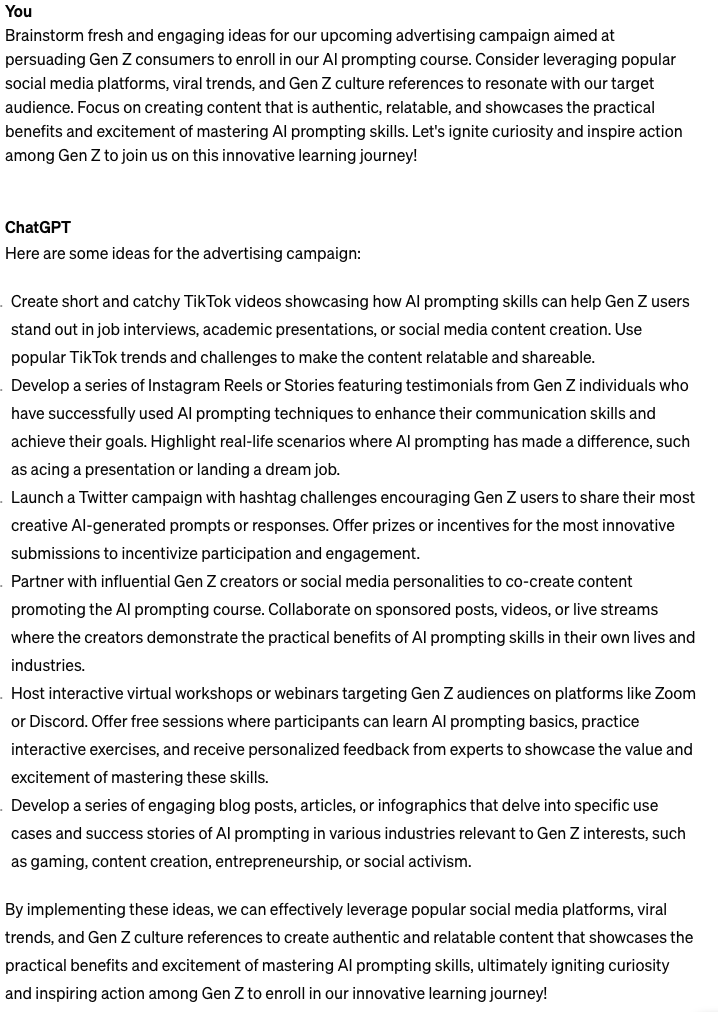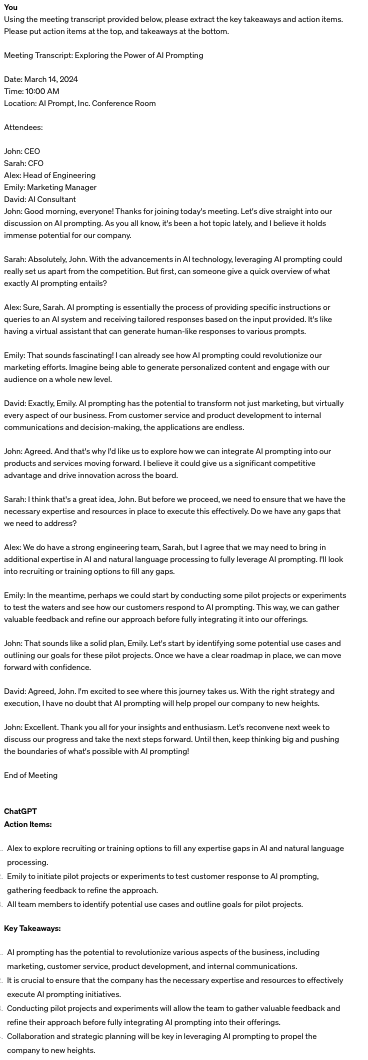Battle of the Prompts: Comparing AI Prompting Strategies
We all know that Artificial Intelligence (AI) has taken the world by storm as one of the biggest technological developments in our current era. By now, you have probably tested the waters with ChatGPT and prompt engineering. The question arises, what is the best approach to these inputs, and why does prompt engineering matter? It’s all about crafting prompts that make AI responses feel natural and relatable, but also accurate and aligned with your intentions.
In this blog, we will delve into the intricacies of prompt engineering. We’ll show you how prompts shape AI’s responses to turn robotic interactions into genuine conversations and give you insights on what goes into creating them.
Understanding Prompt Engineering
So, what exactly does the term prompt engineering mean?
By definition, prompt engineering is the process of refining large language models (LLMs) by tailoring specific prompts and recommended outputs, as well as refining input for various generative AI (GenAI) services to produce text or images.
These generated inputs guide AI responses to give them both personality and flair. Think of these prompts as the AI backbone—they provide the structure and direction for how AI interacts with us. Without prompts, AI is non-existent. Without well-crafted prompts, AI responses might end up feeling robotic, and, well, downright awkward.
That’s where the importance of clear and thorough prompts comes in.
The significance of AI input versus outputs is exemplified through the process of cooking. Let’s use the analogy of the selection of ingredients in cooking to the formation of prompts in AI. Just as using fresh, high-quality ingredients boosts the flavor and quality of a dish, crafting well-designed prompts optimizes the output of generative AI models.
It is simple—better inputs lead to better outcomes.
Prompt-Perfect: Examples and Analysis
Let’s look at a few examples of what makes a prompt almost perfect.
Example 1: The Well-Structured and Specific Prompt:
AI prompting is akin to giving your friend directions to a new restaurant. You wouldn’t just say “Go there”; you’d provide specific steps like “Turn left at the corner” or “Take the second right after the gas station.” Similarly, with AI, you’re guiding it with precise prompts to get the results you want, like asking it to summarize a paragraph or generate a creative story. The goal is to leave no room for ambiguity, making sure AI knows exactly what you’re asking for.
To put this into perspective, let’s say you’re looking to have AI help you write an email to a prospect to determine if they have availability this week for a call to discuss a service they’re interested in: “Write a concise email to the CFO at AI Prompt, Inc., to request their availability this week to discuss our AI prompt engineering consultation services. Please use a conversational and polite tone in the email.”

Why This Prompt Works
The prompt clearly states the purpose of the email: to request the CFO’s availability for a discussion about AI prompt engineering consultation services.
It includes clear instructions, relevant keywords, and any necessary context to guide AI’s response. It also leaves no room for misinterpretation. AI knows exactly what’s expected, allowing it to deliver a precise response.
Example 2: The Creative and Open-Ended Prompt
Now, let’s say you’re in the brainstorming phase for a new advertising campaign targeting Gen Z consumers to sign up for an AI prompting course, and need a little help from AI to spark creativity. This type of prompt encourages AI to think outside the box and come up with unique responses that match the criteria.
Here’s an example: “Brainstorm fresh and engaging ideas for our upcoming advertising campaign aimed at persuading Gen Z consumers to enroll in our AI prompting course. Consider leveraging popular social media platforms, viral trends, and Gen Z culture references to resonate with our target audience. Focus on creating content that is authentic, relatable, and showcases the practical benefits and excitement of mastering AI prompting skills. Let’s ignite curiosity and inspire action among Gen Z to join us on this innovative learning journey!”

Why This Prompt Works
This prompt is more about sparking creativity than providing specific data points as instructions. It’s still well-structured and specific to your needs, but broad enough to get more ideas. It gives AI the freedom to explore different ideas and perspectives, in this case regarding an upcoming campaign. By leaving room for interpretation, this prompt encourages AI to develop multiple unique ideas.
Example 3: The Context-Enhanced Prompt
Last, but not least, this type of prompt combines context and background information to provide more nuanced responses. Let’s say you had a meeting this morning that involved a lot of action items and takeaways and you need a little help extracting the key points.
You can take any context or background information you may have whether it’s a meeting transcript or your meeting notes, and prompt AI for an organized list of meeting takeaways. Here’s an example: “Using the meeting transcript provided below, please extract the key takeaways and action items. Please put action items at the top, and takeaways at the bottom.”

Why This Prompt Works
Unlike the previous examples, this prompt provides AI with additional context or background information. By providing the meeting transcript, this prompt helps AI better understand where to find the context for the action items and key takeaways.
Pro Tip: Adding Voice and Tone to Your Prompt
Adding your own voice and tone within your AI prompts results in a less robotic output and sounds a lot more like what you’d write yourself. Whether you’re scheduling a meeting, sparking creativity on social media, or providing context, remember to give your prompts that personal touch. Trust us, it will be more natural, comprehensible, and beneficial to your business.
Prompts that Plain Suck: What to Avoid
Now that we have covered examples of good AI prompts, let’s focus on some examples of inputs to avoid.
Example 1: The Ambiguous or Vague Prompt
AI needs clear instructions to succeed, just like most humans do. Imagine someone asks you to meet them for lunch on Tuesday but they don’t tell you where and what time. Without clarity, the prompt is trying to go through a maze blindfolded—you’re bound to get lost.
Example: “Create a compelling marketing campaign.”

Why This Prompt Doesn’t Work
This prompt is about as clear as a foggy day. It lacks specificity and leaves AI guessing what the user wants. Without clear instructions, AI often produces responses that miss the mark.
Example 2: The Contradictory or Confusing Prompt
This prompt is exactly how it sounds. Let’s say someone asks you to write an article over two thousand words, but to keep it short. You may wonder how to write a short blog while meeting the lengthy word count.
Here’s an example: “Produce a comprehensive report on AI prompting but keep it concise.”

Why This Prompt Doesn’t Work.
This input gives conflicting instructions. In this example, you can see ChatGPT couldn’t even produce an output, rather, it explains why the prompt is contradictory. With contradictory instructions, AI is left in a state of cognitive dissonance, unsure of which direction to go.
Example 3: The Prompt with Insufficient Context or Information
Finally, imagine a prompt that’s completely bare. This prompt is like trying to solve a puzzle with half the pieces missing – frustrating and with no end in sight.
Example: “Write an email.”

Why This Prompt Doesn’t Work
This prompt is missing crucial context or information, leaving AI flying blind. Without sufficient context, AI will not form an output. ChatGPT will request for more information so that it can accurately fulfill the request.
I understand that many of these points may seem obvious, but you’d be surprised at how easy it can be to use a bad prompt when in a rush. Keep it clear, concise, and context-rich, and you’ll be on your way to prompt perfection in no time.
Promptception: Asking AI To Generate Prompts
Let’s talk about promptception—the unofficial term regarding asking AI to generate prompts for you. It’s like getting a little help from AI to craft the perfect prompt, which you then feed back into the system to get your desired output.
AI prompting techniques like the chain-of-thought technique has revealed another layer of AI prompting. For instance, the revelation that guiding models through step-by-step reasoning improved AI proficiency in solving math or logic problems.
But the surprises didn’t end there. Positive prompts, such as affirmations similar to “you’re as smart as ChatGPT,” sometimes yielded better results. By allowing the model to devise its own prompts, these tools expedite the process and produce superior results in a fraction of the time.
Examples of Prompts for Generating Prompts
Prompt generating can really come in handy. Imagine you need to write an email to a colleague about an upcoming event, but you’re drawing a blank on where to start. So, you turn to AI to ask for a little prompt magic. Here’s an example of what that might look like:
“I’m looking to write an email to a colleague outlining the details from an upcoming event. Can you please provide the best prompt for me to use to have you develop this email? The email must include the following details:
- The event location
- The event time
- The event attendee”
Here are a few tips to keep in mind when using this method:
- Be Specific: The more detailed your initial prompt, the better the AI’s responses will be. Give clear instructions and provide any necessary context to guide AI in the right direction.
- Iterate and Refine: Don’t be afraid to tweak your prompts based on the AI’s response. If you’re not happy with the results, try adjusting your prompt until you get the outcome you’re looking for.
- Experiment and Explore: Promptception is all about creativity and exploration. Don’t be afraid to try out different prompts and see where they take you. You might be surprised by the results!
Key Takeaways
Long story short, the following will put you on the right path to prompting perfection:
- Clarity and Specificity in Prompts: First things first, clarity is key. Be as clear and specific as possible when crafting your prompts. Think of it like giving AI a roadmap—the clearer the directions, the smoother the journey. According to Harvard University, “Using an example of a sentence or paragraph that you’d like your output to resemble can give the AI a reference point to help improve results.”
- Providing Relevant Context and Background Information: Context is essential for inputs. Make sure to provide any relevant background information to help AI understand the user’s needs or intentions. It’s like giving AI a cheat sheet to ace the conversation.
- Avoiding Ambiguity and Contradictory Instruction: Ambiguity is the enemy of effective prompts. Avoid vague or contradictory instructions. Remember, AI can’t read between the lines—it needs clear, concise prompts to work its magic.
- Testing and Iterating Prompts for Optimal Results: Don’t be afraid to experiment with different prompts and iterate based on the results. Prompt engineering is as much art as it is science, so embrace the process of trial and error.
- Staying Up to Date with Prompt Engineering Advancements: Stay ahead of prompt engineering advancements. The world of AI is constantly evolving, and the future is unclear for different AI platforms.
Let Agio clear the path for secure, compliant AI enablement.
Prompt engineering, when done right, makes AI interactions feel natural and seamless. By following best practices like clarity, specificity, and providing relevant context, you can unlock the full potential of AI prompting.
Here at Agio, we can help keep you informed about the impact of AI on your operations. We offer a Microsoft 365 Copilot Readiness Assessment so that you can ensure your firm is getting all the benefits of AI, without risking non-compliance. With our expertise, you can focus less on routine IT tasks and more on strategic initiatives. Contact us today to learn more.
Share post
Featured Posts
Connect with us.
Need a solution? Want to partner with us? Please complete the fields below to connect with a member of our team.




